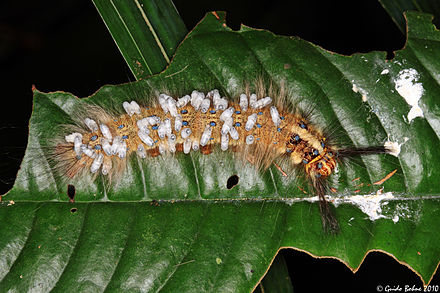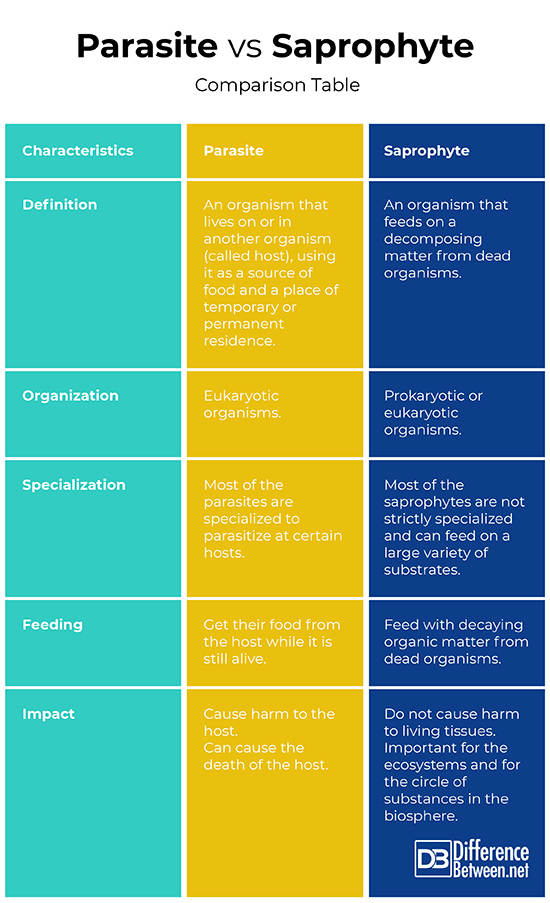Difference Between Parasite and Saprophyte
What is Parasite?
Parasite is an organism that lives on or in another organism (called host), using it as a source of food and a place of temporary or permanent residence. The host does not benefit from cohabitation but may suffer harm. In some cases, the parasite can also be harmed by the host, e.g. some hosts produce antibodies that can reduce the parasite’s fertility, vitality, etc.
Parasites can be plants, animals or fungi. All parasites are eukaryotes.

Unlike predators which directly kill their prey, the parasites do not kill the hosts fast or do not kill it at all.
There is, however, a form of parasitism in which the parasite quickly kills its host. It is called parasitoidism. It is common in some species of wasps, parasitizing on spiders. This form of parasitism is seen as a transient between parasitism and predation.
Depending on the relationships between the parasite and the host in time and space, parasitism can be divided into different categories:
- Obligate and facultative parasites: For the obligate parasites the parasitic existence at least in one life stage is mandatory. The facultative parasites live normally in a free state, but if they fall into a suitable host, they switch to a parasitic way of life.
- Ectoparasites or endoparasites: The ectoparasites parasitize on the surface of the host’s body – its skin, grills, fur or feathers. The endoparasites parasitize inside the host’s body – in its cells, tissues or body cavities. Some parasites can be ectoparasites at certain stages of their development and then become endoparasites.
- Temporary or permanent – The temporary parasites spend their lives outside the hosts and are in contact with them only to feed. The permanent parasites spend their entire lives in a host’s body.
Most of the parasites are specialized to parasitize at certain hosts. In general, the obligatory parasites are more specialized than the facultative ones.
In some cases, the parasites can be hosts as well. This phenomenon is called hyperparasitism.

What is Saprophyte?
Saprophyte is an organism that feeds on a decomposing matter from dead organisms.
Saprophytes can be both eukaryotes and prokaryotes. Such are many bacteria, a significant part of the fungi, certain species of plants and animals.
Most of the saprophytes are not strictly specialized and can feed on a large variety of substrates. Some saprophytic species are specialized and use only one or a limited range of sources of organic matter.
Saprophytic organisms play a very important role in the ecosystems and in the circle of substances in the biosphere. They are a crucial part of the processing of organic matter on Earth. Saprophytes process organic substances from both autotrophic and heterotrophic organisms. Thanks to them, the ground is not covered with dead organic matter.
Some species of saprophytes decompose complex organic substances to simpler ones. Others process simple organic substances to inorganic. There are also species which directly decompose the complex organic substances to inorganic.
The whole variety of saprophytic organisms ultimately converts the organic substances formed by autotrophic and used by heterotrophic organisms into inorganic ones. Thus the inorganic substances are available to autotrophic organisms, which turn them into organic substances again.
Difference Between Parasite and Saprophyte
1. Definition
Parasite: Parasite is an organism that lives on or in another organism (called host), using it as a source of food and a place of temporary or permanent residence.
Saprophyte: Saprophyte is an organism that feeds on a decomposing matter from dead organisms.
2. Organization
Parasite: Parasites are eukaryotic organisms.
Saprophyte: Saprophytes can be prokaryotic or eukaryotic organisms.
3. Specialization
Parasite: Most of the parasites are specialized to parasitize at certain hosts.
Saprophyte: Most of the saprophytes are not strictly specialized and can feed on a large variety of substrates.
4. Feeding
Parasite: Parasites get their food from the host while it is still alive.
Saprophyte: Saprophytes feed with decaying organic matter from dead organisms.
5. Impact
Parasite: In the majority of the cases the parasites cause harm to the host. In some cases, the parasite can cause the death of the host.
Saprophyte: Saprophytes do not cause harm to living tissues. They are very important for the ecosystems and for the circle of substances in the biosphere.
Parasite Vs. Saprophyte: Comparison Table

Summary of Parasite Vs. Saprophyte:
- Parasite is an organism that lives on or in another organism (called host), using it as a source of food and a place of temporary or permanent residence.
- Saprophyte is an organism that feeds on a decomposing matter from dead organisms.
- The parasites are eukaryotic organisms, while the saprophytes can be prokaryotic or eukaryotic organisms.
- Most of the parasites are specialized to parasitize at certain hosts. Most of the saprophytes are not strictly specialized and can feed on a large variety of substrates.
- Parasites get their food from the host while it is still alive. Saprophytes feed with decaying organic matter from dead organisms.
- In the majority of the cases, the parasites cause harm to the host. Saprophytes do not cause harm to living tissues.
- Difference Between Gallstones and Cholecystitis - September 5, 2021
- Difference Between Constipation and Cramping - August 4, 2021
- Difference Between Whole Genome Sequencing and Microarray - May 6, 2021
Search DifferenceBetween.net :
Leave a Response
References :
[0]Dube, H. Textbook of Fungi, Bacteria and Viruses. Mumbai: Promilla Publisher. 2007. Print.
[1]Elevitch, C. The Overstory Book: Cultivating Connections with Trees. Holualoa: Permanent Agricultural Resources. 2004. Print.
[2]Lucius, R., B. Loos-Frank, R. Lane, R. Poulin, C. Roberts, R. Grencis. The Biology of Parasites. Hoboken: John Wiley & Sons. 2017. Print.
[3]Image credit: https://www.flickr.com/photos/humpapa/4971390495
[4]Image credit: https://en.wikipedia.org/wiki/Parasite_load#/media/File:Lappet_moth_caterpillar_parasited_by_braconid_wasps_(Apanteles_sp.)_(5050724084).jpg
